
Date :2019-06-12
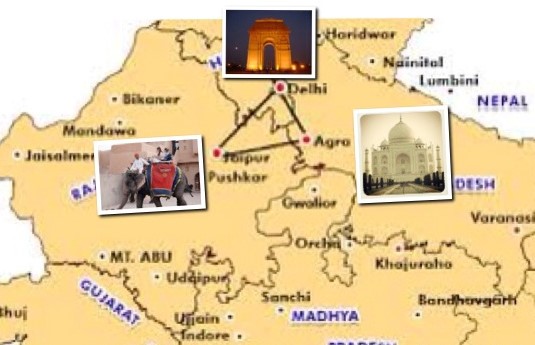
This set of hand embroidered cushion covers / wall hangings are inspired by the heritage architecture of the historical cities of Delhi, Agra & Jaipur, collectively referred to as North India’s Golden Triangle: popularized with the industrialization of travel that began during the British era.
Under the Rohilla Mohalla Project, designs representing prominent monuments in these three cities were carefully selected with the artisans and images of the design details were given to the Rampur Zardozi master artisans Mubashir Shaikh and Iqbal Kamalzai. Being skilled in free hand drawing as well, these artisans at first drew out on tracing paper the essential elements and nuances of the designs to be represented on the final product. The design was transferred on cotton fabric, preparing it for Ari thread embroidery.
The following products were designed and manufactured entirely by hand at the Rohilla Mohalla Training Centre under this theme:
Training focus:
Date :2019-06-12

The architectural remains from the seven ancient cities of Delhi reflect its cultural heritage, signifying layers of history. The oldest fort, Purana Qila stands atop the fabled Indraprastha of the ancient past, the Qutub Minar marks the start of Islamic Rule and Shah Jahan’s Red Fort displays iconic designs in Pietra Dura. The designs from these three monuments form the basis of the Delhi Collection. Each of the cushion covers are of the size: 16”*16”. They are made of 100% Cotton Casement and have been given a border with blue colored silk fabric.
Date :2019-06-12
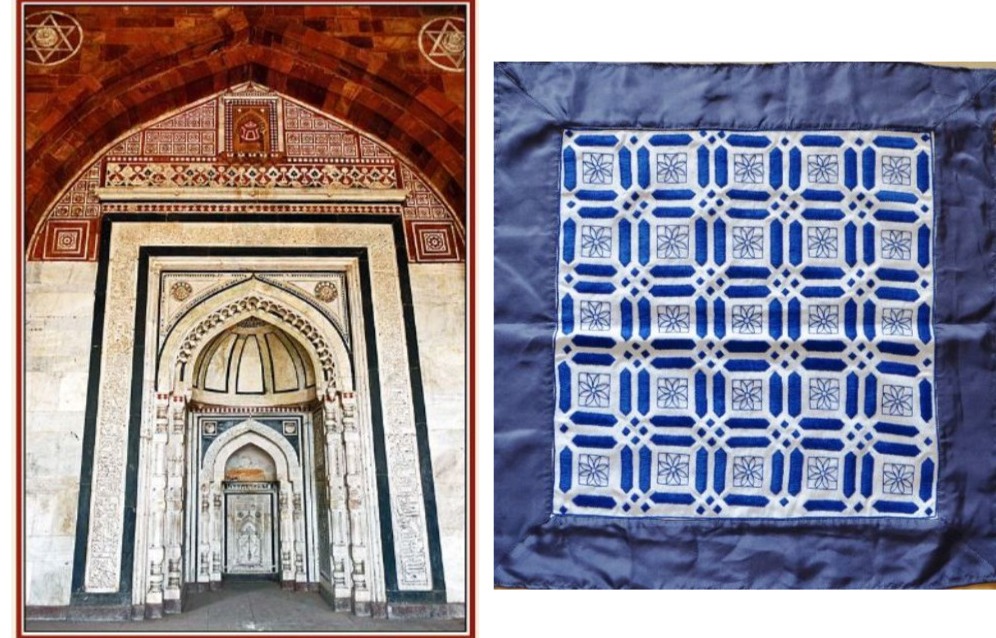
This cushion cover is inspired by the heritage designs at the Qila-i-Kuhna Mosque or the Mosque of the Old Fort built by Sher Shah Suri at the Purana Qila in 1540, to mark his victory over the Mughal Emperor Humanyun. Built as a symbol of royal aspiration, the mosque displays a rich array of art, represented through Islamic geometry tile work & stone inlay work using gold and lapis lazuli especially around the Mihrab. The work is visible even today amidst the partially damaged walls. The Rampur Zardozi artisans replicated part of the inlay work of the mosque on this cushion cover with rich Ari embroidery using blue thread; each cushion cover taking 30-32 hours to complete.
Date :2019-06-12
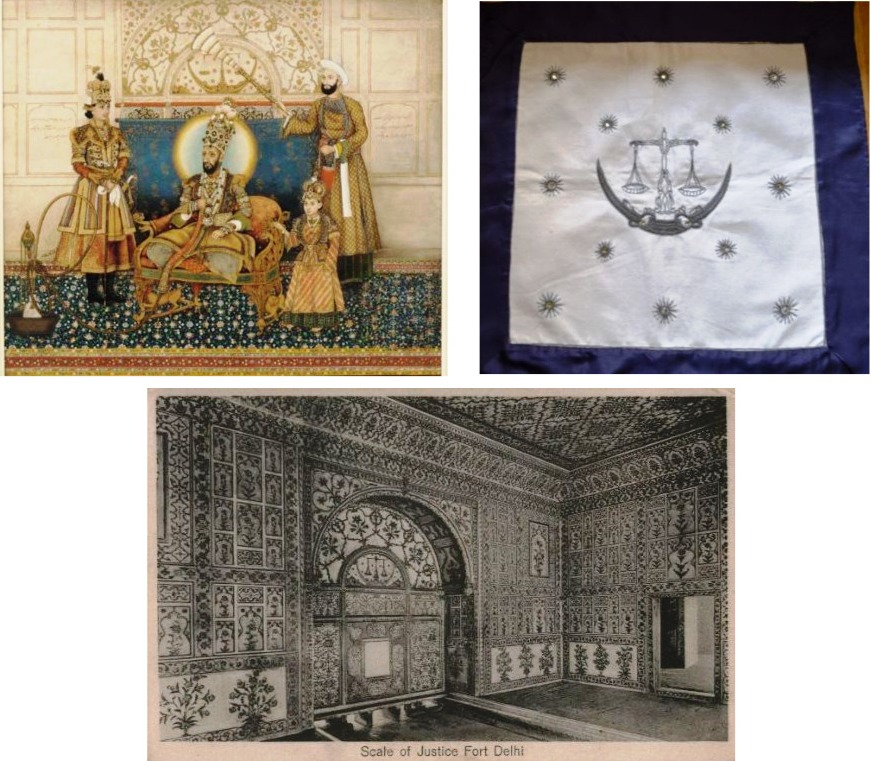
This cushion cover is inspired by the pivotal marble stone tile of “Insaaf-ka-Tarazu” or the Scales of Justice with the iconography of equality in the court of law at the Diwan-e-Khas or the Hall of Private Audiences at the Red Fort. The picture postcard above shows a view of the Diwan-e-Khas with the rich tile work and the colored painting on the left is the Coronation Portrait of the last Mughal Emperor Bahadur Shah Zafar (in 1837) by the artist Ghulam Ali Khan, which also depicts Shah Jahan’s scales of justice in the Diwan-e-Khas . The Rampur Zardozi artisans replicated this important motif on this cushion cover with Ari embroidery using grey thread and mirrors; each cushion cover taking 8-10 hours to complete.
Date :2019-06-12
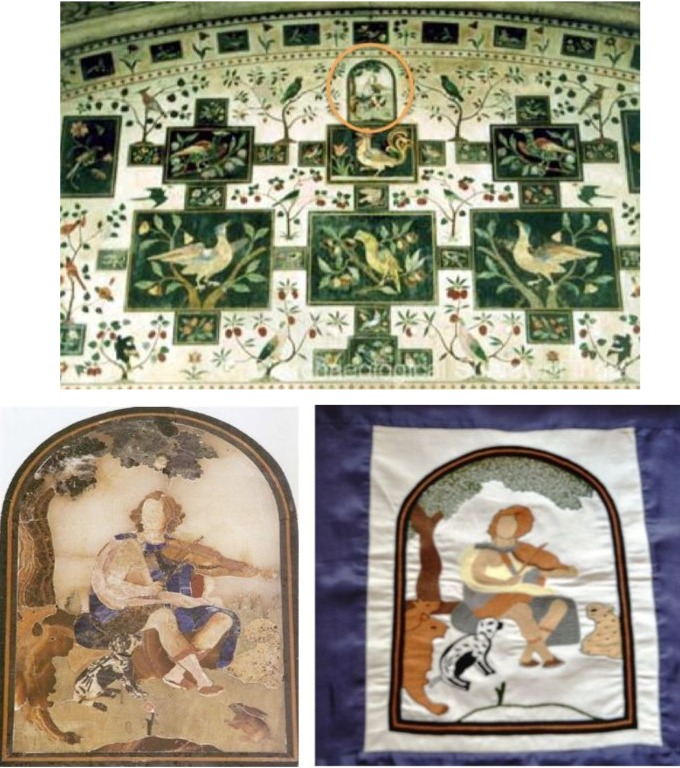
This cushion cover is inspired by the richly decorated murals and Pietra Dura inlay work in the Diwan-e-Aam or the Hall of Audiences at the Red Fort. Behind the throne, where Shah Jahan and his successors heard the grievances of the public, is an image of Orpheus, the legendary musician, poet and prophet in Greek Mythology. It was believed that Orpheus played music with such magical sweetness that he charmed the animals, birds, and reptiles that gathered around him, subduing their innate hostilities. The image at Red Fort shows wild animals and their prey sitting with each other in peace and harmony. The Orpheus theme was one of the most popular amongst the European artists in the 1500s and 1600s, indicating the hope in the power of arts to conquer, and perhaps resolve irreconcilable conflict. Its usage at the Red Fort highlights the influence of the European artists working under Mughal patronage in Delhi and Agra. The motif behind the throne conveys the message of Shah Jahan to his subjects: that in his reign, everyone – the powerful and the weak can live with each other in peace. The Rampur Zardozi artisans have replicated this beautiful theme on cushion covers and wall hangings with rich Ari embroidery using multiple colored threads; each piece taking 30-32 hours to complete.
Date :2019-06-12
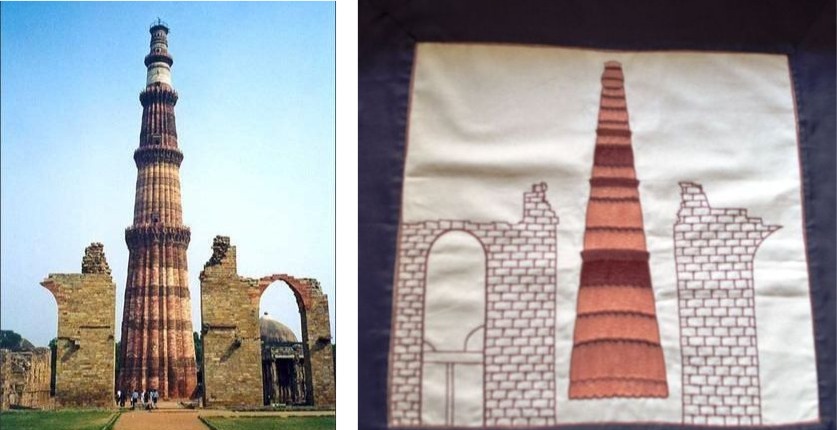
This cushion cover is inspired by one of the oldest Islamic structures of Delhi, the Qutub Minar, the construction of which was started around 1192 by the founder of the Delhi Sultanate, Qutb-ud-din Aibak. It is believed that the inspiration for the tower was drawn from Afghanistan's Minaret of Jam, while also adapting to local artistic conventions by the incorporation of looped bells, garlands and lotus borders into the carving. The Rampur Zardozi artisans replicated this iconic sandstone structure of Delhi on this cushion cover with Ari embroidery using maroon thread; each cushion cover taking 8-10 hours to complete.
Date :2019-06-12
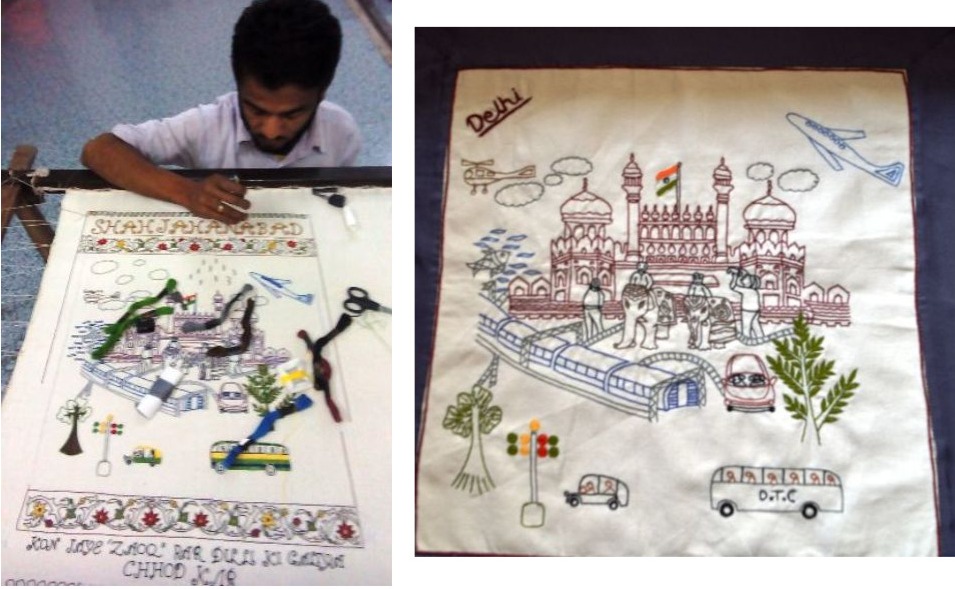
This cushion cover / wall hanging is a collage representing the essence of “Poly-temporal” Delhi of today! The Mughal and Pre Mughal sites remain the main tourist attraction and the DTC and auto rickshaws are here to stay; the traffic on the roads and in the skies has multiplied may fold. Though Delhi prides itself in being the first Indian city to get connected by the Metro to enable faster commute, one can still enjoy the sites by slow travel on the back of an elephant, reminiscent of the Mughal era, and also at the same time explore Shahjahanabad in a cycle rickshaw!
Ustad Zauq, a great poet of 19th century Delhi and the literary mentor of the last Mughal king, Bahadur Shah Zafar was tempted with a lucrative job in the Deccan when Delhi was being repeatedly plundered; he declined the offer with these legendary lines:.
“In dinon garche dakkan mai hai badi qadr-e-sukhan, Kaun jaye “zauq” par dilli ki galiyan chhod kar” (Albeit in Deccan, the Muse commands respect, Who, after all, O Zauq, can leave the alleyways of Delhi).
Zauq's Poetry on attachment with Delhi is often still-quoted when people express their love towards this city in these changing times. The essential Delhi-ness as imagined creatively by the Rampur Zardozi artisans under the Rohilla Mohalla project has been embroidered on this cushion cover / wall hanging with Ari embroidery using multiple colored threads, each piece taking 15-20 hours to complete.
Date :2019-06-12

There is more to the Taj Mahal than symmetry & white marble. Subtle designs line both its exterior & interiors. The same can be said about Itmad-ud-Daula, the tomb of the parents of Mughal Empress Noor Jahan. Intricate geometric & floral patterns in stone inlays, largely in muted colours cover both these monuments lavishly. The products in the Agra Collection have been inspired by the heritage designs of the Taj Mahal and the Itmad-ud-Daula. Each of the cushion covers are of the size: 16”*16”. They are made of 100% Cotton Casement and have been given a border with deep red colored silk fabric.
Date :2019-06-12
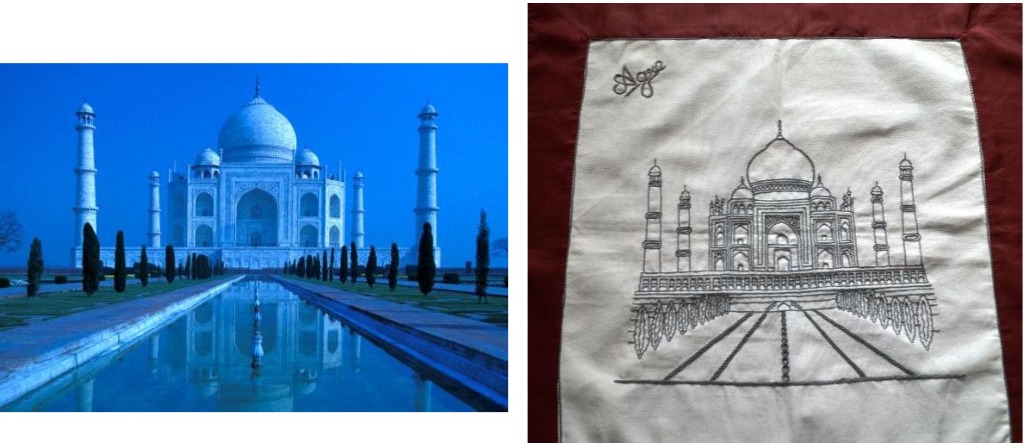
Rabindranath Tagore described the Taj Mahal as “a teardrop on the cheek of time”. This elegant cushion cover is embroidered with the outline of the Taj Mahal in perfect symmetry. Embroidered using the Ari technique with grey thread, this design captures the beauty of the Taj best viewed on a full moon night. Each piece took 15-20 hours to complete.
Date :2019-06-12
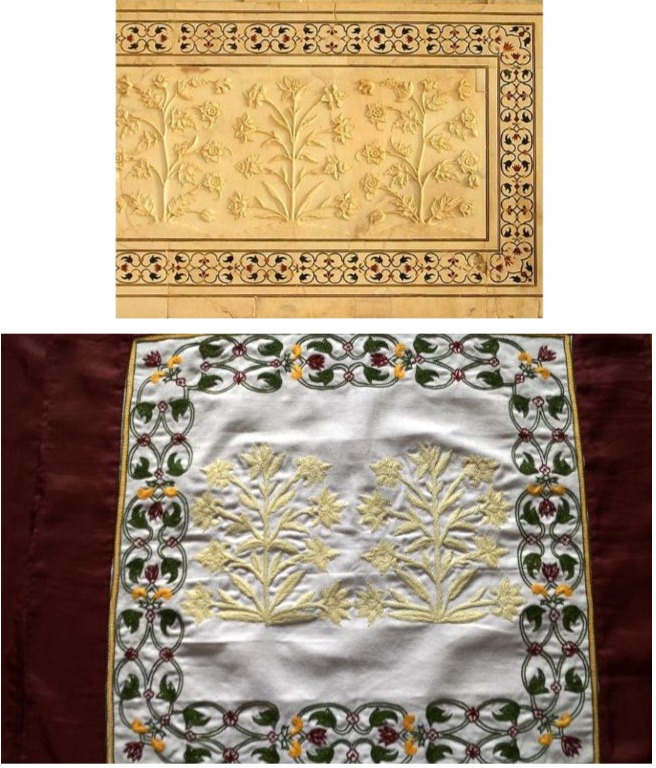
This exquisite cushion cover is inspired by the marble stone carving and the Italian Pietra Dura or the Parchin Kari stone inlay work from the corridors of the Taj Mahal. The Bouquet design and the floral inlay patterns with precious and semi precious stones have been artistically recreated on this heavily embroidered cushion cover with Ari embroidery using multiple colored threads, each piece taking 20-25 hours to complete.
Date :2019-06-12
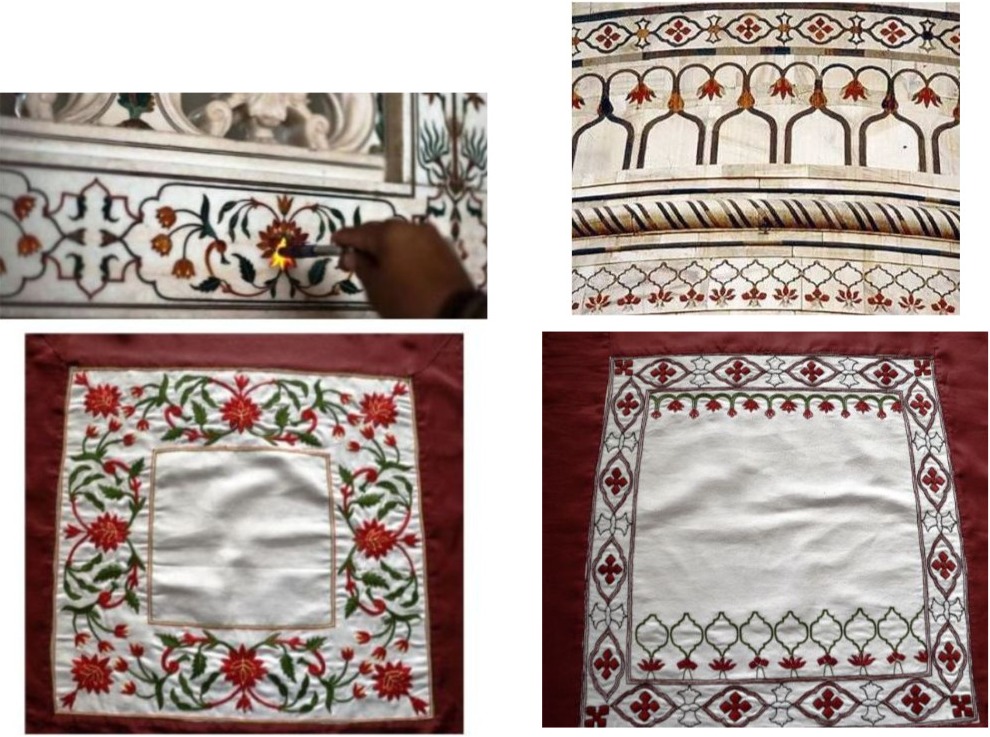
These two cushion covers capture the essence of the Taj – replicating the stone inlay work called Pietra Dura or Parchin Kari that adorns the exterior walls of the Taj Mahal. Using the Ari embroidery technique, these floral patterns with precious and semi precious stones have been recreated along the border of these cushion cover using multiple colored threads; each piece taking 15-20 hours to complete.
Date :2019-06-12
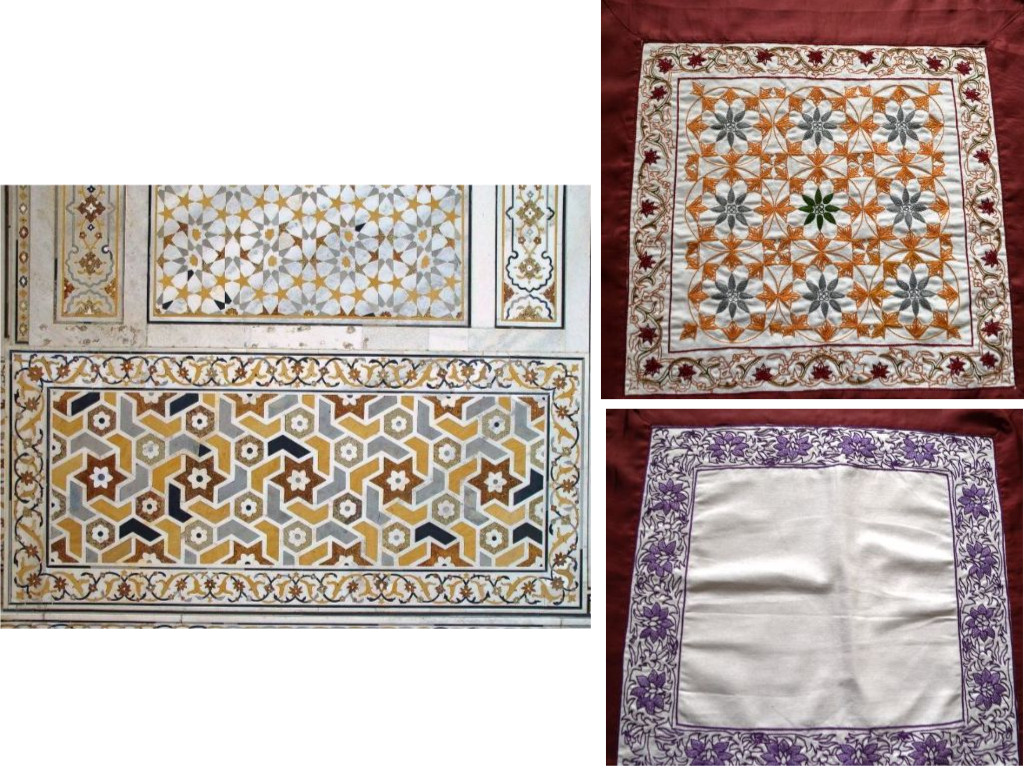
Itmad – ud- Daula was built between 1622-6 by Noor Jahan as a tomb for her parents. This was the first Mughal structure to be built completely from marble, making extensive use of Pietra Dura, as against the earlier structures which used red sandstone. Probably an inspiration for building the Taj Mahal, this structure looks exquisite with the light filtering in through the jaalis on the delicate inlay work on its walls. Intricate geometric patterns from this monument have been embroidered on the cushion cover using the traditional Ari embroidery technique; each cushion taking 25-30 hours to complete.
Date :2019-06-12
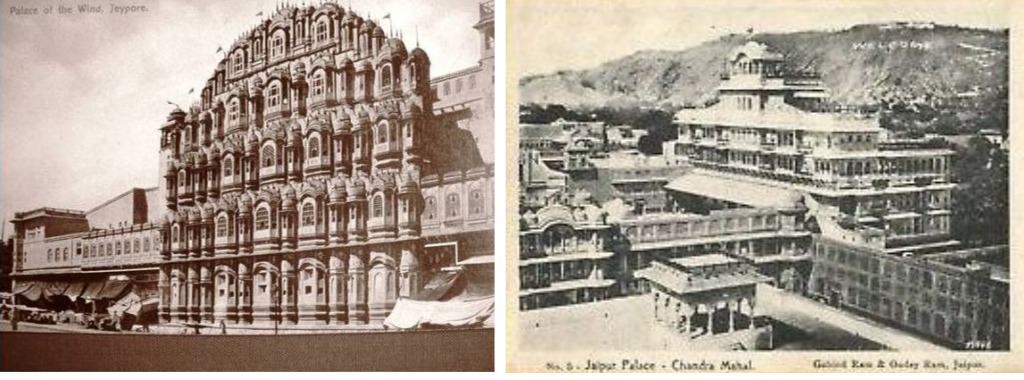
Rajasthan’s state capital is a celebration of the desert. Nothing captures the essence of the Pink City more than the Hawa Mahal & the City Palace. The architecture of these palaces is a fusion of elements from the Shilpa Shastras with the Rajput, Mughal and European architectural elements.
Hawa Mahal was built in 1799 during the reign of Maharaja Sawai Pratap Singh and the City Palace was built between 1729 and 1732 by Raja Jai Singh II, a keen architectural enthusiast. The inner courtyard of the City Palace provides access to the royal residence and museum at Chandra Mahal, and is adorned with four small gates known as Ridhi Sidhi Pol. These gates are decorated with themes representing the four seasons and Hindu gods, evoking good luck for all who enter through them. The products in the Jaipur collection are inspired by these heritage designs on the gates of the Chandra Mahal and the Hawa Mahal. Each of the cushion covers are of the size: 16”*16”. They are made of 100% Cotton Casement and have been given a border with pink colored silk fabric.
Date :2019-06-12
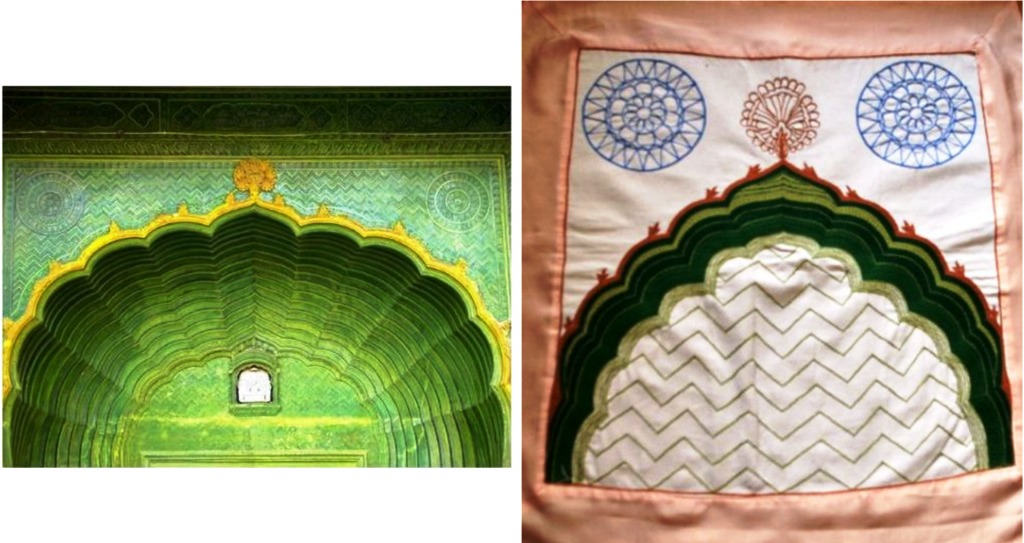
The Green Gate, also called the “Leheriya” or waves gate is located on the North West of the City Palace courtyard. The green wavy pattern is representative of spring and the gate is dedicated to Lord Ganesha. The artistic interpretation of the Green gate on this cushion cover has been entirely hand embroidered using the Ari technique; each piece taking 20-25 hours to complete.
Date :2019-06-12
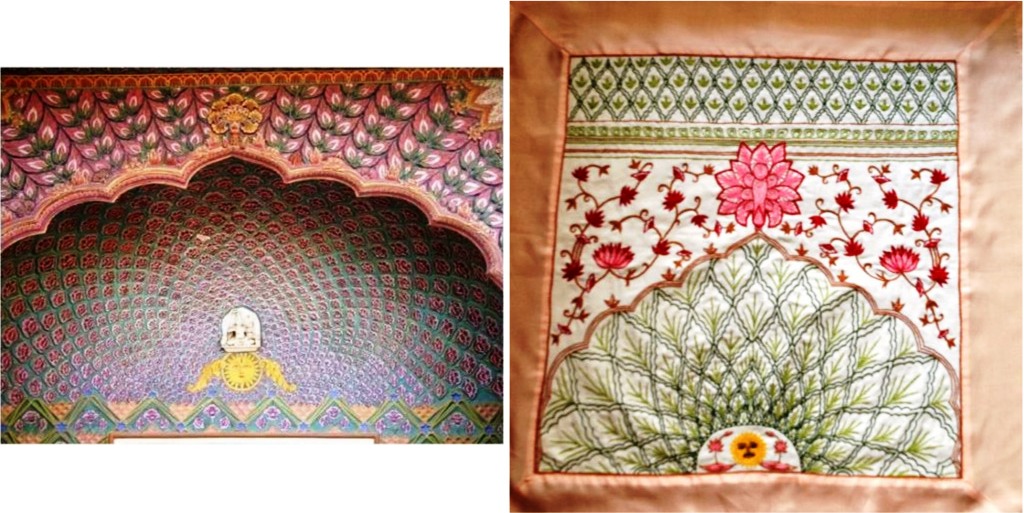
The Lotus Gate is located on the South West of the City Palace courtyard. With a continual lotus petal pattern and the face of Surya, the gate represents the summer season, and is dedicated to Lord Shiva and his consort Parvati. The artistic interpretation of the Lotus gate on this cushion cover has been entirely hand embroidered using the Ari technique; each piece taking 20-25 hours to complete.
Date :2019-06-12
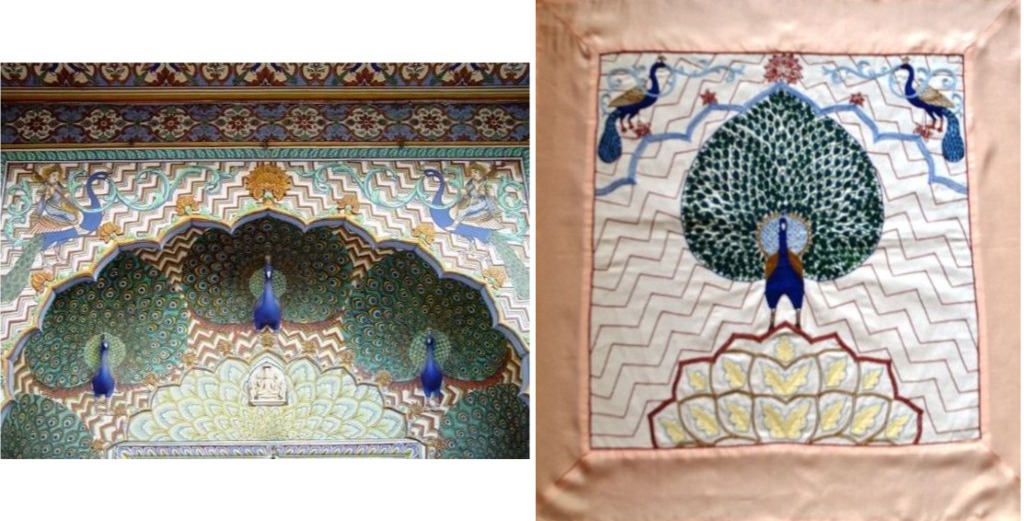
The Peacock Gate is located on the Northeast of the City Palace courtyard. With motifs of peacocks on the doorway, the gate represents the season of autumn and is dedicated Lord Vishnu. The artistic interpretation of the Peacock gate on this cushion cover has been entirely hand embroidered using the Ari technique; each piece taking 20-25 hours to complete.
Date :2019-06-12
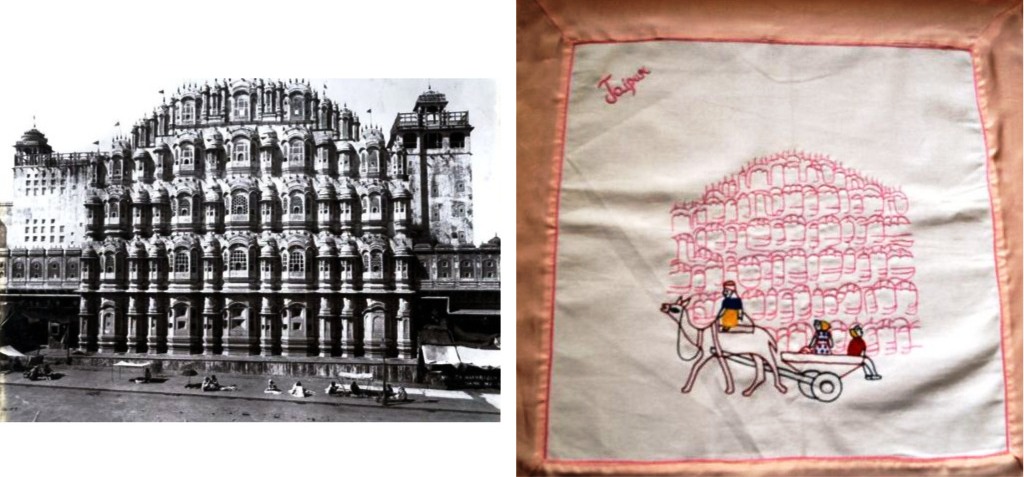
This cushion cover is inspired by the red and pink sandstone Hawa Mahal or Palace of Winds of Jaipur. The exterior high screen wall akin to a honeycomb of a beehive was believed to be modeled in the shape of Lord Krishna’s crown. The artistic interpretation of the Hawa Mahal on this cushion cover has been entirely hand embroidered using the Ari technique; each piece taking 12-15 hours to complete.